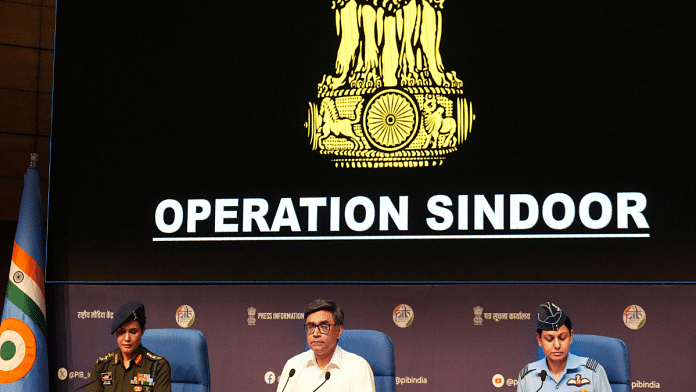Thank you dear subscribers, we are overwhelmed with your response.
Your Turn is a unique section from ThePrint featuring points of view from its subscribers. If you are a subscriber, have a point of view, please send it to us. If not, do subscribe here: https://theprint.in/
Fifth, Operation Sindoor was not just a demonstration of India’s military resolve – it was a coming-of-age moment for the nation’s indigenous defence ecosystem. In bypassing Pakistan’s Chinese-origin radar and air defence systems, India deployed a potent mix of home-grown Electronic Warfare suites, loitering munitions, and integrated command systems that underscored the credibility of the Make in India push in defence technology. Central to this success was the deployment of Akashteer, India’s cutting-edge air defence control and reporting system developed by BEL, which enabled seamless integration across radar, weapons, and communication networks. Even legacy platforms like the L70 anti-aircraft guns (originally from the 1950s) and the ZU-23-2 guns (a 1960s Soviet-era design) were retrofitted with electro-optical fire control systems and fused with AI-enabled tracking, proving how vintage hardware can be reborn through smart upgrades.
Adding a strategic layer of autonomy was the use of NavIC (Navigation with Indian Constellation), India’s indigenous satellite navigation system, which replaced dependence on GPS and GLONASS for precision targeting and coordination. Clearly, we have learned the lesson from 1999 Kargil war in which the Americans refused to lend GPS support to us. Supporting this was the Indian Integrated Air Defence System (IIAS), a multi-tiered network that allowed real-time threat tracking and decision-making across Army, Navy, and Air Force assets. In many ways, Operation Sindoor was a field test, and validation of India’s aspiration for tech sovereignty in defence. No imports. No dependencies. Just capability. And clarity.
There is growing belief that the Indian Air Force may have deployed advanced drones engineered to mimic the radar and infrared (IR) signatures of frontline fighter jets like the Rafale or Su-30MKI. These decoys, designed to appear indistinguishable from actual aircraft on enemy radar, could have baited Pakistan into prematurely activating its China-supplied HQ-9 air defence systems, which rely on active radar guidance. By doing so, Pakistan may have inadvertently exposed the positions of its critical Command & Control centres, radar installations, surface-to-air missile (SAM) batteries and other defences. Once these systems lit up and revealed themselves, they became vulnerable targets – potentially taken out by Israeli-origin Harop loitering munitions, also known as suicide drones, known for their precision strikes on radar-emitting targets. Could this electronic sleight of hand be the kind of silent war India is winning – one where cunning and capability outmatch brute force? Only time will tell, and I am not asking my air force to come clean on this. I am happy that I am safe.
The Escalation Doctrine: A New Indian Military Posture
From special forces to full-spectrum joint operations, India’s response trajectory under the Modi government signals a deliberate recalibration of deterrence.
Sixth, there have been three major incidents since the coming-to-power of the BJP government with Mr. Modi as the leader of the nation, to which India responded with precise, well-planned, and deliberate military strikes. The first being at Uri in September 2016 (19 Indian Army soldiers killed), the second at Pulwama in February 2019 (40 CRPF personnel killed), and this being the third in Pahalgam in 2025 (25 Indian and 1 Nepali tourist killed). Every time, the response moved decisively up the escalatory ladder – Special Forces across the LoC in 2016, deep-penetration airstrikes in Balakot in 2019, and now, in 2025, a tri-service operation involving coordinated strikes by the Army, Air Force, and Navy.
This progression is not accidental. It reflects a strategic doctrine in evolution – one that refuses to let precedent constrain action, and instead uses each provocation as an inflection point to redefine deterrence. By engaging across domains, land, air, and sea, India has communicated that its threshold for tolerance has narrowed, and its spectrum of response has widened. The message is clear: terror will be answered, not with rhetoric, but with resolve – and escalation will be India’s to decide, not Pakistan’s to manipulate.
When Will Pakistan Strike Again?
That is the billion-dollar question now, isn’t it? The fact is that Pakistan will strike again. We have not yet completely resolved our vulnerability against their terror attacks. We have a shield now though – not that of technology and capability alone. But that of policy, of shrinking our threshold of our patience. The government of India has made it clear to the world – terror and talks, and terror and trade, are oxymorons in our dictionary. Terror attack in India now equals war on India. Uri happened in 2016, Pulwama 3 years later in 2019, and Pahalgam 6 years later in 2025. Will the next attack come 12 years later in 2037? I pray that it comes never.
This is the concluding part of the two-part series. With inputs from Priyanka Sharma Kaintura.
These pieces are being published as they have been received – they have not been edited/fact-checked by ThePrint.


